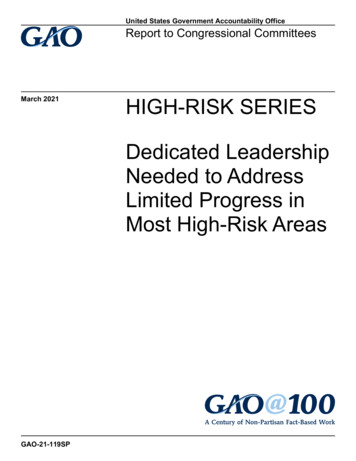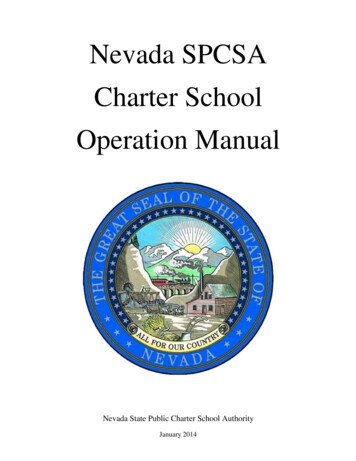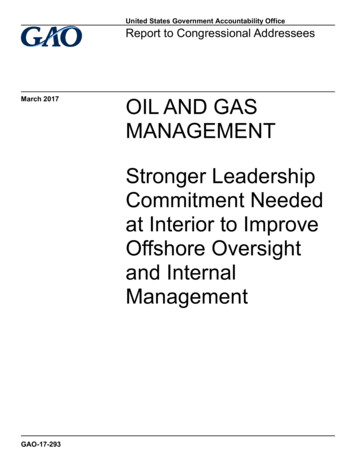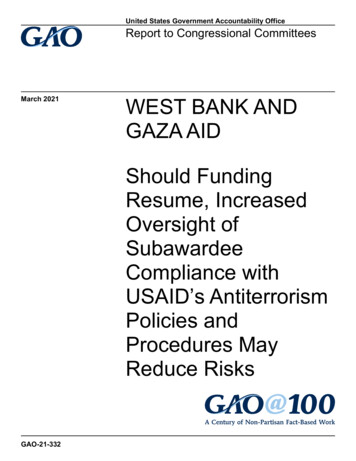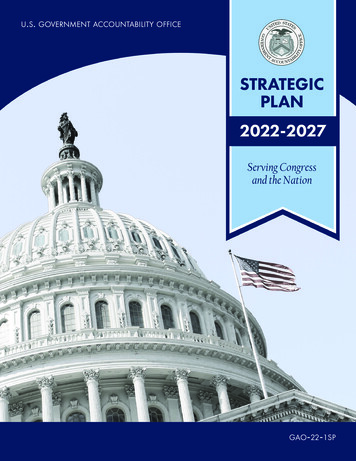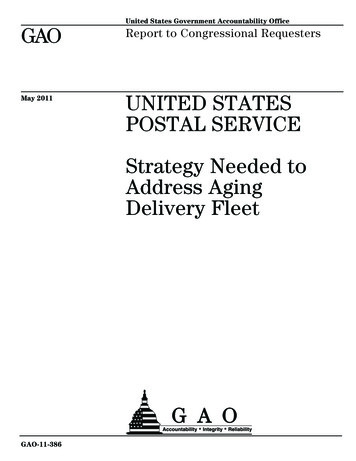
Transcription
United States Government Accountability OfficeGAOReport to Congressional RequestersMay 2011UNITED STATESPOSTAL SERVICEStrategy Needed toAddress AgingDelivery FleetGAO-11-386
May 2011UNITED STATES POSTAL SERVICEStrategy Needed to Address Aging Delivery FleetAccountability Integrity ReliabilityHighlights of GAO-11-386, a report tocongressional requestersWhy GAO Did This StudyWhat GAO FoundThe United States Postal Service(USPS) has the world’s largestcivilian fleet, with many of itsdelivery vehicles reaching the end oftheir expected 24-year operationallives. USPS is subject to legislativerequirements governing the federalfleet, including a requirement in theEnergy Policy Act of 1992, whichprovides that 75 percent of USPS’svehicle acquisitions be alternativefuel vehicles, capable of operating ona fuel other than gasoline. USPS isalso facing serious cost pressures inmaintaining a national network ofprocessing and retail operations.USPS’s delivery fleet is largely composed of custom-built, right-hand-drivevehicles designed to last for 24 years, including about 141,000 gasolinepowered vehicles 16 to 23 years old and 21,000 flex-fuel vehicles capable ofrunning on gasoline or 85-percent ethanol (E85) that are about 10 years old.The fleet also includes 22,000 left-hand-drive minivans, many of which are alsocapable of running on E85, and 3,490 delivery vehicles capable of running onother alternative fuels. Delivery vehicles are driven an average of about 17miles per day and cost about 1 billion to maintain and fuel in fiscal year 2010.Asked to review USPS’s deliveryfleet, GAO (1) profiled the fleet;(2) assessed USPS’s response toalternative fuel vehicle requirementsand described its experiences withthese vehicles; (3) identified USPS’sapproach for addressing its deliveryfleet needs, including trade-offs; and(4) determined options to fund amajor acquisition of delivery vehicles.GAO analyzed USPS data; visitedUSPS facilities in three locations; andinterviewed officials from USPS, theDepartment of Energy, and otherorganizations, including fleetoperators and manufacturers.What GAO RecommendsUSPS should develop a strategy foraddressing its delivery fleet needsthat considers the effects of likelyoperational changes, legislative fleetrequirements, and other factors.USPS agreed with GAO’srecommendation.View GAO-11-386 or key components.For more information, contact Phil Herr at(202) 512-2834 or herrp@gao.gov.Delivery Vehicles at a USPS Maintenance Facility (left) and Post Office (right)Source: GAO.USPS met the 75 percent acquisition requirement for alternative fuel vehiclesby purchasing about 40,000 flex-fuel vehicles and minivans that can operateon E85 or gasoline. However, USPS does not always use E85 in these vehiclesbecause E85 is not readily available and can cost more to use due to less fuelefficiency, according to USPS officials. USPS has a variety of limitedexperiences with other alternative fuel vehicles, such as compressed naturalgas and plug-in electric vehicles, most of which have higher life-cycle coststhan gasoline vehicles.USPS’s approach for addressing its delivery fleet needs is to maintain itscurrent fleet until it determines how to address its longer term needs. USPShas incurred small increases in direct maintenance costs over the last 5 years,which were about 2,600 per vehicle in fiscal year 2010. However, it isincreasingly incurring costs for unscheduled maintenance because ofbreakdowns, which can disrupt operations and increase costs. In fiscal year2010, at least 31 percent of USPS’s vehicle maintenance costs were forunscheduled maintenance, 11 percentage points over USPS’s 20 percent goal.USPS’s financial challenges pose a significant barrier to a major deliveryvehicle replacement or refurbishment, estimated to cost 5.8 billion and (in2005) 3.5 billion, respectively. USPS and other federal and nonfederalofficials see little potential to finance a fleet replacement through grants orpartnerships. GAO has reported that Congress and USPS need to reachagreement on a package of actions to move USPS toward financial viability.Depending on the specific actions adopted, USPS’s follow-up, and the results,such an agreement could enhance its ability to invest in new delivery vehicles.United States Government Accountability Office
ContentsLetter1BackgroundUSPS’s Delivery Fleet Primarily Consists of LLVs That AreApproaching the End of Their 24-Year Expected OperationalLivesUSPS Has Acquired Alternative Fuel Vehicles in Response toRequirements, but Has Experienced ChallengesUSPS’s Approach for Addressing Its Delivery Fleet Needs HasFinancial, Operational, and Environmental Trade-offsWithout Significant Improvement in USPS’s Financial Condition,There Are No Clear Options to Fund a Major VehicleReplacementConclusionsRecommendation for Executive ActionAgency Comments440454647Appendix IObjectives, Scope, and Methodology48Appendix IIUSPS’s Experiences with Non-E85-CapableAlternative Fuel Vehicles55Appendix IIIComments from the United States Postal Service60Appendix IVGAO Contact and Staff Acknowledgments6281524TablesTable 1: Types of Delivery Routes and Number of USPS VehiclesUsed for Each Route, as of September 30, 2010Table 2: Profile of the Three Main Categories of USPS DeliveryVehicles, as of September 30, 2010Table 3: Number of USPS Delivery Vehicles, by Alternative FuelCapability, as of September 30, 2010Table 4: Nonfederal Organizations InterviewedPage i5121454GAO-11-386 United States Postal Service
FiguresFigure 1: USPS LLVs, 2010Figure 2: Example of an LLV and FFV, 2010Figure 3: USPS Minivan Used for Delivering Mail, 2010Figure 4: Number of Gas Stations that Sell E85 in Each State, as ofDecember 31, 2010Figure 5: Gas Station Sign Advertising E85 near a Minnesota PostOffice with E85-Capable Delivery Vehicles in September2010, and Decals on the Fuel Cap Door of a USPS DeliveryMinivan Indicating That It Is E85 CapableFigure 6: Average USPS Price for E85 and Gasoline in Fiscal Year2010 and the Fuels’ Relative EfficiencyFigure 7: Annual Average Maintenance Cost Per Vehicle for USPS’sDelivery Fleet over the Past 5 Fiscal YearsFigure 8: Proportion of USPS’s Delivery Vehicles in EachMaintenance Cost Range, Fiscal Year 2010Figure 9: New LLV Frames Awaiting Installation (left), and an LLVBeing Reassembled after a Frame Replacement (right),2010Figure 10: Example of Rust in Lower Half of Body Mount at a PostOffice in Florida, 2010Figure 11: Rusted Frame with Holes Being Replaced in a USPSVehicle Maintenance Facility in New York State, 2010Figure 12: A Ford Windstar Minivan Being Repaired at a PostalVehicle Maintenance Facility (left) and a NonoperationalMinivan Up on Blocks Being Used for Parts (right), 2010Figure 13: Example of an Unused Compressed Natural Gas FuelPump at a Post Office in Huntington, New York, 2010Figure 14: T-3 Electric Personal Mobility Delivery Vehicle, 2010Figure 15: One of Two Hybrid 2-Ton Delivery Vehicles in Huntington,New York, 2010Page ii21011161720313334363739565859GAO-11-386 United States Postal Service
AbbreviationsDOEEPAct 1992FFVGSALLVUPSUSPSVMASDepartment of EnergyEnergy Policy Act of 1992flex-fuel vehiclesGeneral Services Administrationlong-life vehiclesUnited Parcel ServiceUnited States Postal ServiceVehicle Management Accounting SystemThis is a work of the U.S. government and is not subject to copyright protection in theUnited States. The published product may be reproduced and distributed in its entiretywithout further permission from GAO. However, because this work may containcopyrighted images or other material, permission from the copyright holder may benecessary if you wish to reproduce this material separately.Page iiiGAO-11-386 United States Postal Service
United States Government Accountability OfficeWashington, DC 20548May 5, 2011The Honorable Joseph LiebermanChairmanThe Honorable Susan CollinsRanking MemberCommittee on Homeland Securityand Governmental AffairsUnited States SenateThe Honorable Tom CarperChairmanThe Honorable Scott BrownRanking MemberSubcommittee on Federal Financial Management,Government Information, Federal Services,and International SecurityCommittee on Homeland Securityand Governmental AffairsUnited States SenateThe Honorable John McCainUnited States SenateThe United States Postal Service (USPS) operates the world’s largestcivilian vehicle fleet, with more than 215,000 vehicles, of which about192,000 are delivery vehicles.1 These vehicles are vital to accomplishingUSPS’s mission of delivering mail to about 131 million residential andbusiness addresses, in most cases, 6 days a week.2 The majority of USPS’sdelivery fleet is composed of custom-built, right-hand-drive, light-dutydelivery trucks that it refers to as “long-life vehicles” (LLV)—vehicles builtwith an aluminum body and other features intended to permit an extendedoperational life of 24 years (see fig. 1). Purchased from 1987 to 1994, theLLVs are now approaching the end of their expected operational lives.1In addition to delivery vehicles, USPS’s fleet includes other vehicles, such asadministrative vehicles used for sales, accident investigations, and other purposes, andlarger trucks used for hauling mail.2USPS also delivers to another 20 million addresses as part of its post office box service.Page 1GAO-11-386 United States Postal Service
Figure 1: USPS LLVs, 2010Source: GAO.USPS is required to provide efficient mail service and is expected to payfor its operations through the revenue it receives.3 USPS also is required tocomply with certain legislative requirements governing the federal fleet.For example, under the Energy Policy Act of 1992 (EPAct 1992), 75percent of the light-duty vehicles that USPS acquires must be capable ofusing an alternative fuel.4As we previously reported, USPS’s business model is not viable because ithas been unable to reduce costs sufficiently in response to continuingdeclines in mail volumes and revenue, and it faces growing financialchallenges for the foreseeable future.5 Specifically, mail volumes havedeclined about 20 percent over the last 4 fiscal years because of theeconomic downturn and the public’s changing use of the mail. In addition,over the same period, USPS’s financial condition has deteriorated, withcumulative losses of more than 20 billion and rising debt. For fiscal year2011, USPS projects a 6.4 billion loss and expects to reach the 15 billionstatutory limit on its debt. USPS’s ongoing financial challenges led us toplace USPS’s financial condition and outlook on our high-risk list in July339 U.S.C. §§ 101(a), 403(a).4Pub. L. No. 102-486, § 303, 106 Stat. 2766 (Oct. 24, 1992).5GAO, U.S. Postal Service: Strategies and Options to Facilitate Progress towardFinancial Viability, GAO-10-455 (Washington, D.C.: Apr. 12, 2010).Page 2GAO-11-386 United States Postal Service
2009.6 We have reported that action by Congress and USPS is needed on apackage of actions that will allow USPS to move toward financial viabilityby reducing costs, increasing efficiency, and generating revenues.7In view of USPS’s difficult financial condition, you asked us to reviewmatters related to USPS’s aging delivery fleet. To do so, we addressed thefollowing key questions: (1) What is the profile of USPS’s delivery fleet?(2) How has USPS responded to requirements for alternative fuel vehicles,what experiences has it had with alternative fuel vehicles, and what has itlearned from its experiences? (3) What, if any, approach has USPSadopted to address its delivery fleet needs, and what are the trade-offs ofthis approach? (4) What options exist to help USPS fund a majoracquisition of delivery vehicles?To address our reporting objectives, we collected and analyzed data onUSPS’s delivery fleet for fiscal years 2006 through 2010, using data from acustom query of USPS’s Vehicle Management Accounting System (VMAS).To supplement this information, we also reviewed data from reportsgenerated by VMAS (VMAS reports) that USPS officials regularly use totrack the agency’s vehicle maintenance and fuel costs. The VMAS reportscategorize vehicles somewhat differently than our custom query, andtherefore the numbers of vehicles identified in these two sources cannotbe compared directly. Through these two sources, we developed a profileof USPS’s delivery fleet from fiscal years 2006 through 2010, includingmost direct costs related to the vehicles’ maintenance, excluding costsrelated to accidents. Based in part on electronic testing and interviewswith USPS officials knowledgeable about VMAS system controls andvehicle data procedures, we determined that the VMAS data weresufficiently reliable for the purposes of this report. In addition, we workedwith USPS Finance and Vehicle Programs officials to obtain a USPSestimate of the total maintenance and fuel costs for the agency’s deliveryfleet in fiscal year 2010. We compared this estimate with cost summariesand other information provided by USPS finance officials that supportedamounts reported in USPS’s audited financial statements for fiscal year2010 and determined that the agency’s estimate was reasonable. We also6See GAO, High Risk Series: Restructuring the U.S. Postal Service to Achieve SustainableFinancial Viability, GAO-09-937SP (Washington, D.C.: July 28, 2009). USPS’s financialcondition and outlook remained on our high-risk list in 2011. See GAO, High Risk Series:An Update, GAO-11-278 (Washington, D.C.: Feb. 16, 2011).7GAO-10-455.Page 3GAO-11-386 United States Postal Service
conducted site visits to three states (Florida, Minnesota, and New York),chosen because they represent a variety of climates and operatingconditions and because USPS operates various types of alternative fueldelivery vehicles in these locations. During our site visits, we intervieweda variety of USPS personnel, including facility managers, maintenancetechnicians, and letter carriers. We also reviewed prior studies on USPS’sfinancial challenges, federal fleet alternative fuel vehicle requirements andagencies’ experiences with these technologies, federal principles forcapital planning, and documentation on USPS’s environmentalsustainability goals. Finally, we interviewed USPS, Department of Energy(DOE), and General Services Administration (GSA) officials and a widerange of officials from companies with large vehicle fleets, such as FedExExpress and United Parcel Service (UPS); automobile manufacturers;alternative fuel associations; and environmental organizations.We conducted this performance audit from February 2010 to May 2011 inaccordance with generally accepted government auditing standards. Thosestandards require that we plan and perform the audit to obtain sufficient,appropriate evidence to provide a reasonable basis for our findings andconclusions based on our audit objectives. We believe that the evidenceobtained provides a reasonable basis for our findings and conclusionsbased on our audit objectives. Appendix I provides additional informationon our scope and methodology.BackgroundUSPS’s mission is to provide reliable, affordable, and universal maildelivery and postal retail services to the entire U.S. population as nearly aspracticable, regardless of where people live. In the past 5 years, USPS’sdelivery workload has increased on average by about 1 million deliverypoints, or addresses, per year—from 126 million in fiscal year 2006 toabout 131 million in fiscal year 2010.8 USPS organizes its delivery pointsinto city and rural routes. Most city routes fall into one of three maintypes, as shown in table 1.8As noted, USPS also delivers mail to another 20 million addresses as part of its post officebox service.Page 4GAO-11-386 United States Postal Service
Table 1: Types of Delivery Routes and Number of USPS Vehicles Used for EachRoute, as of September 30, 2010aNumber ofUSPS vehiclesused for eachroute typeRoute typeDefinitionCityA route designated as serving city locations, ratherthan rural areas. USPS provides vehicles for allmotorized city routes.160,006Park and loopThe letter carrier drives the vehicle to a designatedparking location. The carrier then walks a segmentof the route before driving to the next location andwalking another segment of the route.80,564CurblineThe letter carrier delivers to mailboxes at the curb,typically without leaving the vehicle.50,517DismountThe letter carrier exits the vehicle and delivers mailto the door. Dismount routes include carrier pickups at collection boxes.14,058OtherThis category includes walking, bicycle, andexpress package routes.14,867A route designated as serving rural areas. Suchroutes typically involve curbline delivery. Becauseof suburban development, over time, many ruralroutes now resemble city curbline routes.32,299RuralbTotal192,305Source: GAO analysis of a custom query of VMAS data.Note: USPS also has highway contract routes. These routes are not included in this table becauseUSPS does not provide vehicles for these routes.aUSPS characterizes routes based on the type of delivery for the majority of each route. According toVehicle Programs officials, many routes involve more than one type of delivery.bMany rural routes are operated with privately owned vehicles.In its two most recent contracts with the National Rural Letter CarriersAssociation,9 USPS agreed to provide about 40,000 right-hand-drivevehicles for many of its rural routes from 2004 to 2013. As of December 31,2010, USPS had provided rural letter carriers with 33,060 of thecontractually required vehicles. According to USPS officials, USPS expectsto provide the remaining vehicles by the end of December 2013. Accordingto USPS officials, USPS provides the vehicles to rural carriers with low9The current collective bargaining agreement between USPS and the National Rural LetterCarriers Association expired on November 20, 2010. At the conclusion of our review, USPSand the association were in negotiations.Page 5GAO-11-386 United States Postal Service
mileage routes and based on other considerations, such as the vehicle’sproximity to fuel and a USPS vehicle maintenance facility and theadequacy of security for the vehicle. While these agreements significantlyexpanded the number of rural letter carriers who operated USPS vehicles,as of March 11, 2011, 41,026 rural letter carriers still used their personalvehicles for USPS mail deliveries.USPS is an independent establishment of the federal government, with aBoard of Governors, which has responsibilities similar to a corporation’sboard of directors, that oversees its operations and expenditures,including those for major capital investments. Over the past 4 years,capital investments declined from 2.7 billion in fiscal year 2007 to 1.4billion in fiscal year 2010. According to USPS officials, most capitalexpenditures since fiscal year 2008 have been for investments that areexpected to provide cost savings, such as automated mail sortingequipment, and none of these expenditures have been for deliveryvehicles. However, as a result of appropriations to GSA under theAmerican Recovery and Reinvestment Act of 2009, USPS received about6,500 new, more fuel-efficient vehicles from GSA in 2009 and 2010 in a onefor-one exchange for older, less fuel-efficient USPS vehicles.10To help address its financial challenges, in March 2010, USPS issued a 10year action plan, or strategy, in which it proposed, among other things,reducing mail delivery from 6 days to 5 days a week and enhancing itsability to close underutilized postal offices. The plan did not include astrategy for addressing the agency’s delivery fleet needs. USPS also hasmade operational changes to reduce costs, such as deploying a newsystem that automatically sorts and sequences large envelopes andmagazines into the order in which they are to be delivered. According toUSPS, this system reduces the time letter carriers must spend preparingmail for delivery and allows for consolidation of delivery routes intofewer, but longer, routes.11 USPS is also working to enhance its revenuesthrough initiatives such as the introduction of flat-rate boxes for PriorityMail and volume-based rate incentives to stimulate additional mail use.Operational changes will affect USPS’s future fleet needs.10According to USPS officials, while a small number of these vehicles (minivans) are usedfor mail delivery, the majority are used for administrative purposes such as sales, accidentinvestigation, and Office of Inspector General operations.11From fiscal year 2009, when USPS implemented a route reduction program, through fiscalyear 2010, the total number of city and rural routes decreased by 13,423.Page 6GAO-11-386 United States Postal Service
USPS is subject to certain provisions of EPAct 1992 related to federalagency vehicle fleets. The act—designed to improve energy efficiency—requires that 75 percent of light-duty vehicles acquired for federal fleets inmajor metropolitan areas be capable of using alternative fuels. Alternativefuel vehicles must be capable of using one of a variety of fuel types, suchas ethanol, natural gas, propane, biodiesel, electricity, or hydrogen.Legislation subsequently expanded the definition of alternative fuelvehicles to include hybrid vehicles and any other type of vehicle that canachieve a significant reduction in petroleum consumption, asdemonstrated by the Administrator of the U.S. Environmental ProtectionAgency. Legislation also subsequently required that all dual-fuel vehiclesuse alternative fuel unless they have received a waiver from DOE.12 DOEgrants waivers to agencies that operate vehicles in areas where alternativefuel is unavailable, not available within 5 miles or 15 minutes of travel, ormore expensive per gallon than gasoline at the same fuel station.13In February 2011, USPS had 306 vehicle maintenance facilities distributedamong its seven area offices.14 According to USPS officials, the agency alsouses contractors at private maintenance facilities, such as garages, toperform some of its vehicle maintenance, and their use has increased inrecent years, partly because the number of USPS technicians has declinedunder a hiring freeze. USPS tracks its vehicles’ performance and costs,including maintenance work and costs, through VMAS, according to USPSofficials. Field and headquarters offices get periodic VMAS reports onvarious vehicle performance indicators, and data on vehicle accidents arekept in a separate database.USPS’s Office of Vehicle Programs, which is under the Vice President ofDelivery and Post Office Operations, is responsible for fleet management,leasing, maintenance policies and procedures, parts, vehicle research,development and testing, and new vehicle acquisitions. In addition, USPS’sOffice of Sustainability coordinates and establishes energy andenvironmental goals for the fleet. Consistent with legislative requirements,by fiscal year 2015 (compared with a fiscal year 2005 baseline), USPS’sgoals are to reduce petroleum fuel use by 20 percent and increase12Pub. L. No. 109-58, § 701, 119 Stat. 594 (Aug. 8, 2005).13Gasoline is distilled from petroleum. We used the terms “gasoline” and “petroleum”interchangeably throughout this report.14Area offices are designated as Capital Metro, Eastern, Great Lakes, Northeast, Pacific,Southwest, and Western.Page 7GAO-11-386 United States Postal Service
alternative fuel use by 10 percent annually (for an overall increase of 100percent over the 10-year period).15In its fiscal year 2010 Strategic Sustainability Performance Plan, USPSreported that it did not expect to meet its 2015 petroleum reduction goal.Specifically, USPS reported that from fiscal years 2005 through 2009, itsdelivery fleet’s use of petroleum increased because of growth in thenumber of its delivery addresses. According to USPS, its proposal toreduce delivery from 6 days to 5 days a week has the largest petroleumreduction potential, but even if Congress approves the proposal, it wouldnot be likely to meet its fiscal year 2015 goal. In contrast, USPS reportedthat it had already met its second goal because, from fiscal years 2005through 2009, its use of alternative fuel increased by 114 percent.USPS’s Delivery FleetPrimarily Consists ofLLVs That AreApproaching the Endof Their 24-YearExpected OperationalLivesLLVs, Flex-Fuel Vehicles,and Minivans Are thePrincipal Components ofUSPS’s Delivery FleetThe number of half ton and smaller vehicles in USPS’s delivery fleet—mostly LLVs, flex-fuel vehicles (FFV), and minivans—has remainedrelatively constant over the past 5 fiscal years, ranging from 182,517 to189,712 vehicles,16 despite about 13,400 fewer delivery routes. The numberof delivery vehicles peaked in fiscal year 2008, before falling slightly, andgrew overall by 3,487 vehicles, or about 2 percent, over the 5-year period.15Pub. L. No. 110-140, § 142, 121 Stat. 492 (Dec. 19, 2007).16These data are from year-end reports for fiscal years 2006 to 2010 that include one-halfton vehicles and smaller vehicles that comprise the vast majority of USPS’s delivery fleet.Because vehicles are categorized somewhat differently in VMAS reports than in our customquery, the quantity of vehicles between the two data sources cannot be compared directly.Page 8GAO-11-386 United States Postal Service
Despite some recent vehicle purchases, the majority of USPS’s fleetconsists of LLVs, which are approaching the end of their 24-year expectedoperational lives. Produced by Grumman, the LLVs were acquired from1987 through 1994, before EPAct 1992’s light-duty vehicle acquisitionpercentage requirements went into effect in fiscal year 1996.17 The LLVshave light-weight and long-lasting aluminum bodies mounted on a GeneralMotors chassis and are powered by a 4-cylinder gasoline engine. USPSacquired the second major segment of the delivery fleet, FFVs, in 2000 and2001, after EPAct 1992’s acquisition requirements went into effect. TheFFVs have an aluminum body that is similar to that of the LLV. Accordingto USPS officials, FFVs are mounted on a Ford Explorer platform and arepowered by a 6-cylinder engine that is “flex-fuel” capable, meaning that itcan use gasoline or E85, a mixture of gasoline and ethanol (85 percent).LLVs and FFVs, which together make up about 84 percent of USPS’sdelivery fleet, are easily identifiable as mail delivery vehicles (see fig. 2).These vehicles are built on a light truck chassis (light-duty vehicles) andhave a cargo capacity of 1,000 pounds with 108 cubic feet of cargo space.Key features of both include right-hand drive, an open interior for storingmail, and sliding doors. According to USPS, right-hand-drive vehicles arenecessary for curbline delivery so that letter carriers can safely delivermail directly to mail boxes without leaving their vehicles. Because righthand-drive vehicles can be used for all routes, they also provideoperational flexibility, allowing managers to move them to any routewhen, for example, another right-hand-drive vehicle is out of service formaintenance. In addition, Vehicle Programs officials told us that astandardized design minimizes training requirements and facilitates theestablishment of partnerships with part suppliers.17Specifically, in fiscal year 1996, EPAct 1992 required that 25 percent of all federal fleetacquisitions be for alternative fuel vehicles. The legislation increased the percentage ofalternative fuel vehicles required for acquisitions in each subsequent year until fiscal year1999, when the 75 percent acquisition requirement was reached. Pub. L. No. 102-486, § 303(b).Page 9GAO-11-386 United States Postal Service
Figure 2: Example of an LLV and FFV, 2010Source: GAO.FFVs have an extra window behind the door for improved visability.LLVThe LLVs’ and FFVs’ bodies were made to withstand harsh operatingconditions. USPS officials explained that the typical delivery operatingcycle is extremely hard on vehicles because of the large number of stopsand starts each day (an average of about 500 stops and starts per deliveryroute). In addition, when the letter carrier frequently exits and re-entersthe vehicle, doors are opened and closed, and keys are turned in the doorlocks and ignition far more often than in a typical personal vehicle.The third major segment of the delivery fleet, shown in figure 3, consists ofcommercially available minivans. While USPS modified these minivans foruse as delivery vehicles,18 according to USPS officials, they do not haveright-hand drive and therefore cannot be used on all routes, reducingoperational flexibility. In addition, commercially available vehicles are notbuilt to withstand the harsh operating conditions of mail delivery and,consequently, the minivans have an expected operating life of 10 years.Most of USPS’s minivans are E85-capable, meaning that they can operateon either E85 or gasoline.18For example, security or safety screens were installed in the cargo area, the drivercompartment and passenger seats were removed, and the vehicles were painted to identifythem as USPS vehicles.Page 10GAO-11-386 United States Postal Service
Figure 3: USPS Minivan Used for Delivering Mail, 2010Source: GAO.Table 2 provides a profile of the three main types of delivery vehicles thatcollectively account for about 96 percent of USPS’s 192,305 deliveryvehicles. Other types of vehicles are used to deliver mail in certain areas.These vehicles include sport utility vehicles and larger 2-ton trucks, whichtypically are used for mail collection, not deliveries.Page 11GAO-11-386 United States Postal Service
Table 2: Profile of the Three Main Categories of USPS Delivery Vehicles, as of September 30, 2010Vehicle typeAcquisitionyearsVehicleacquisitionacosts (adjusted Mean agefor inflation)(years)Age range(years)Estimatedvehicle life(years)Average milesdriven perday/yearNumberin fleetLLV1987–1994 6–200817,500f2.62–41014/4,20310,186Min
The United States Postal Service (USPS) operates the world's largest civilian vehicle fleet, with more than 215,000 vehicles, of which about 192,000 are delivery vehicles. 1. These vehicles are vital to accomplishing USPS's mission of delivering mail to about 131 million residential and business addresses, in most cases, 6 days a week. 2
